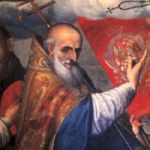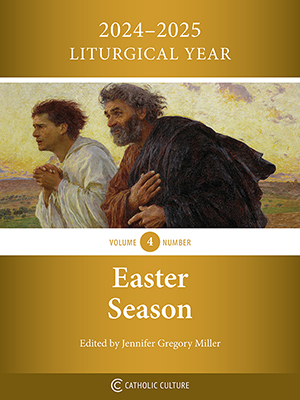The Advent Wreath
A Baptist friend asked me about the Advent wreath — its history, meaning, etc. ... I think I gave her a pretty good answer. Perhaps you could provide a little more information. — An ACH reader via email.
The Advent wreath is part of our long-standing Catholic tradition. However, the actual origins are uncertain. There is evidence of pre-Christian Germanic peoples using wreaths with lit candles during the cold and dark December days as a sign of hope in the future warm and extended-sunlight days of spring. In Scandinavia during winter, lit candles were placed around a wheel, and prayers were offered to the god of light to turn "the wheel of the earth" back toward the sun to lengthen the days and restore warmth.
By the Middle Ages, the Christians adapted this tradition and used Advent wreaths as part of their spiritual preparation for Christmas. After all, Christ is "the Light that came into the world" to dispel the darkness of sin and to radiate the truth and love of God (cf. Jn 3:19-21). By 1500, both Catholics and Lutherans had more formal practices surrounding the Advent wreath.
The symbolism of the Advent wreath is beautiful. The wreath is made of various evergreens, signifying continuous life. Even these evergreens have a traditional meaning that can be adapted to our faith: The laurel signifies victory over persecution and suffering; pine, holly and yew, immortality; and cedar, strength and healing. Holly also has a special Christian symbolism: The prickly leaves remind us of the crown of thorns, and one English legend tells of how the cross was made of holly. The circle of the wreath, which has no beginning or end, symbolizes the eternity of God, the immortality of the soul and the everlasting life found in Christ. Any pine cones, nuts or seedpods used to decorate the wreath also symbolize life and resurrection. All together, the wreath of evergreens depicts the immortality of our soul and the new, everlasting life promised to us through Christ, the eternal Word of the Father, who entered our world becoming true man and who was victorious over sin and death through His own passion, death and resurrection.
The four candles represent the four weeks of Advent. A tradition is that each week represents 1,000 years, to sum to the 4,000 years from Adam and Eve until the birth of the Savior. (This tradition is exemplified in the work of Anglican Archbishop James Ussher who in his 1650 treatise The Annals of the Old Testament, Deduced from the First Origin of the World, gave the date of Creation at 4004 BC; interestingly, he even pinpointed Oct. 23 at noon.) Three candles are purple and one is rose. The purple candles in particular symbolize the prayer, penance and preparatory sacrifices and good works undertaken at this time. The rose candle is lit on the third Sunday, Gaudete Sunday, when the priest also wears rose vestments at Mass; Gaudete Sunday is the Sunday of rejoicing, because the faithful have arrived at the midpoint of Advent, when their preparation is now half over and they are close to Christmas. The progressive lighting of the candles symbolizes the expectation and hope surrounding our Lord’s first coming into the world and the anticipation of His second coming to judge the living and the dead.
The light again signifies Christ, the Light of the world. Some modern day adaptions include a white candle placed in the middle of the wreath, which represents Christ and is lit on Christmas Eve. Another tradition is to replace the three purple and one rose candles with four white candles, which will be lit throughout Christmas season.
In family practice, the Advent wreath is most appropriately lit at dinnertime after the blessing of the food. A traditional prayer service using the Advent wreath proceeds as follows: On the First Sunday of Advent, the father of the family blesses the wreath, praying: "O God, by whose word all things are sanctified, pour forth Thy blessing upon this wreath, and grant that we who use it may prepare our hearts for the coming of Christ and may receive from Thee abundant graces. Who livest and reignest forever. Amen." He then continues for each of the days of the first week of Advent, "O Lord, stir up Thy might, we beg thee, and come, that by Thy protection we may deserve to be rescued from the threatening dangers of our sins and saved by Thy deliverance. Who livest and reignest forever. Amen." The youngest child then lights one purple candle.
During the second week of Advent, the father prays: "O Lord, stir up our hearts that we may prepare for Thy only begotten Son, that through His coming we may be made worthy to serve Thee with pure minds. Who livest and reignest forever. Amen." The oldest child then lights the purple candle from the first week plus one more purple candle.
During the third week of Advent, the father prays: "O Lord, we beg Thee, incline Thy ear to our prayers and enlighten the darkness of our minds by the grace of Thy visitation. Who livest and reignest forever. Amen." The mother then lights the two previously lit purple candles plus the rose candle.
Finally, the father prays during the fourth week of Advent, "O Lord, stir up Thy power, we pray Thee, and come; and with great might help us, that with the help of Thy grace, Thy merciful forgiveness may hasten what our sins impede. Who livest and reignest forever. Amen." The father then lights all of the candles of the wreath. Of course, this prayer service can be adapted to meet a family’s particular needs.
Since Advent is a time to stir-up our faith in the Lord, the wreath and its prayers provide us a way to augment this special preparation for Christmas. Moreover, this good tradition helps us to remain vigilant in our homes and not lose sight of the true meaning of Christmas.
Fr. Saunders is dean of the Notre Dame Graduate School of Christendom College in Alexandria and pastor of Our Lady of Hope Parish in Potomac Falls.
Copyright ©2001 Arlington Catholic Herald. All rights reserved.
This item 3994 digitally provided courtesy of CatholicCulture.org






